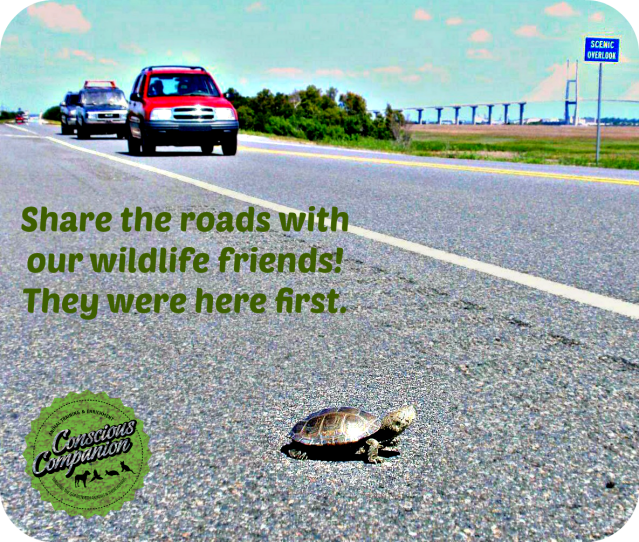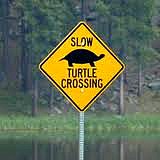We are facing a turtle survival crisis unprecedented in its severity and risk. Humans are the problem, and must therefore also be the solution. Without concerted conservation action, many of the world’s turtles and tortoises will become extinct within the next few decades. It is now up to us to prevent the loss of these remarkable, unique jewels of evolution. ~ Turtle Conservation Coalition

World Turtle Day is May 23, so I wanted to remind everyone to be conscious of these very special animals that share the roads with us! Where we live, we are surrounded by natural wetlands. But there are highways and roads that also surround these wetlands. This often means that native turtles do not fare well when they need to cross the busy roads. I have seen far more than my share of injured and crushed turtles in the three years that we have lived here, and every time I find one, my heart breaks. Many of these turtles are endangered or threatened species. Yet, most people don’t seem to know this, or don’t even care. This is where we come into play! Helping one turtle across the road can be the difference between life and death for the animal, and for future generations. Educating our friends and family is how we can save species.
Turtles and tortoises are among the world’s most endangered vertebrates, with about half their more than 300 species threatened with extinction. Only primates—human beings expected—are at greater risk of being wiped off the planet.
April through October are the months that you will see many turtles actively crossing roads in the United States. They do this for many reasons; in the spring, males are looking for females and territory to call their own. May and June is nesting season. At this time egg-bearing, female aquatic turtles leave the water to find terrestrial nesting sites, and this often requires crossing a road. During late summer and fall, hatchling turtles are digging up from nests, looking for water. Then later in the year males and females are heading to safe places for winter hibernation. Other times they will migrate to find a more suitable spot to live.

The worst threat to snapping turtles is vehicle traffic. Each year many females get killed in their search for nesting sites. Often vehicles will not stop or even deliberately hit turtles because snapping turtles are disliked by many people. Nests on road sides and in gravel pits are often destroyed by vehicles and road grading. Hatchlings on their way back to the water are frequently run over. ~Tortoise Trust

Although pre-dating dinosaurs by several million years, turtles everywhere are fast disappearing today. The “hide in my shell and wait it out” strategy that has enabled turtles to weather the geologic changes leading to the extinction of countless other species, however, has proven of little use in surviving the peril posed by fast moving trucks and cars. ~Dept. of Natural Resources
You can literally save a life – and even an entire species – by taking a few minutes out of our day to help them safely cross the road!
How to help turtles safely across the road:
- Safety First! Busy roads and highways are dangerous for humans and animals. Turn on your hazard lights and carefully pull off to the side of the road. Make sure other drivers see you, before stepping onto the road.
- Determine if the turtle is injured. If he or she is injured, call your veterinarian to see if they will take it. They may refer you to another vet that does accept injured wildlife.
- Injured turtles: If you see a turtle on the road that has been hit, PLEASE STOP to help it! He/she may not be dead! Reptiles, especially turtles, have an extraordinary capacity to remain alive, even with severely injured. They can do this because of their slow their metabolic rate. The benefit of a low resting metabolism is that it requires far less fuel to sustain bodily functions. This enables them to survive for long periods of time, even when injured! Turtles can often survive, even if their shell is crushed, if they are given medical treatment in time. I have saved countless turtles who had been hit on the road by getting them to a vet in time. Don’t let him/her just lay there suffering and baking in the sun! Take them to a veterinary clinic near you. Call the vet to let them know you are coming. If the veterinarian does not have the ability to help you, they will send you to a veterinarian who specializes in reptiles and exotics, or wildlife specialist. More about What to do if you find an injured turtle. Check out some pictures of an injured turtle being repaired!
- When picking up a small to medium turtle, grasp it firmly and confidently on both sides of its shell between the front and rear legs (along its side). Turtles have long legs and claws, so they might be able to kick at you, but don’t freak out. Most will choose to stay safely tucked in their shell, during the brief time that you are moving them.
- Keep the turtle low to the ground when moving them. Even small turtles have surprising strength. If a turtle pushes free of your grip, you do not want it to fall and injure itself.
- If it’s a very large turtle, it may be a snapping turtle, or a softshell turtle. Both species can be large, heavy, and quite feisty. They have a very wide reach with their neck and powerful jaws, so be careful. I would not advise picking it up, but you can still help it cross the road by staying nearby – out of its way – while it continues to cross. Let the passing cars see you and the turtle so they can safely go around you and the turtle. Learn more here about how to help snapping turtles and softshell turtles here. The video below demonstrates how to use your car mat to move one of these turtles safely across the road:
- NEVER EVER PICK UP ANY TURTLE BY THE TAIL. This can severely injure them.
- Place the turtle in the direction it was heading. NEVER TURN THEM AROUND! The turtle is on a mission and if you turn it around, it will just head back across the road when you are out of sight.
- Do not move the turtle to a “better spot.” Many people are tempted to relocate a turtle. Turtles have a home range and females often return to the same general area to lay their eggs. When relocated, they will often search for ways back to their “home base”. Not only do these relocated turtles risk more road crossings, but if they cannot find their way back, will wander far and become lost.
- Don’t be a Turtle-Napper! Do not ever remove a turtle from its habitat. They are not pets. They belong in the wild.
- Report turtle sightings to your local Fish and Game’s Reptile and Amphibian Reporting Program.
- Work with land trusts and town officials to help conserve important natural areas in your community.
- Recommended Resources:
—> You can save a turtle! A project by Kawartha Turtle Trauma Centre
—> Help a Turtle Across the Road [ Help A Turtle ] by the Minnesota Herpetological Society
—> Roadways and Turtles: Solutions for Safety_flyer
—> Discover turtles and tortoises in your state!
—> Turtle & Tortoise Species Specific Sites
—> A Field Guide to Turtles: Eastern and Central North America
Whatever the reason a turtle is traveling, their destination can take him or her miles away from where they live. As humans continue to encroach upon their habitats, turtles will be crossing more roads. Research has shown that aquatic turtle populations across the United States have uncommonly high proportions of males because so many female turtles are being killed on roadways. Turtles have a long lifespan, take a long time to reach sexual maturity, and have low survivorship when newly hatched. Because of these attributes, turtle populations cannot compensate for losses due to adult mortality without experiencing long-term consequences. With turtle populations requiring high levels of adult survivorship, every individual is important to a population’s stability. This concern is even greater in recent years because many U.S. turtle populations are becoming fragmented, isolated, and progressively smaller.
It’s up to each of us to ensure that turtle species stay abundant, healthy and safe!
“For if one link in nature’s chain might be lost, another might be lost, until the whole of things will vanish by piecemeal.”– U.S. President Thomas Jefferson




Pingback: Poster for World Turtle Day (May 23) | Millard Fillmore's Bathtub
Helping snapping turtles is easy if you have a broom handle or stick for it to bite onto–crosswise, of course…Then carefully, slowly drag him forward…always in the direction he’s going!!
LikeLike
Gotta be careful dragging them. Their skin on their legs can tear easily, but yes I have heard of that technique, if you’re not comfortable or experienced with picking up a defensive snapper! 😉
Thanks, Dianne!
LikeLike
Pingback: How turtles got their shells | Dear Kitty. Some blog
Amy this is a wonderfully helpful post! I did successfully “herd” a small snapping turtle out of the road once but it wasn’t pleased with me! I have carried a dozen or more land turtles across, in the right direction of course. Lots of people seem to want to help. Sometimes it will be a group effort between strangers, where someone moves the turtle and another stops traffic.
Anyway, it’s great to read about how to help these guys. Thanks for this.
LikeLike
Thank you, Eileen! I love to hear that so many others are doing their part to help turtles and tortoises! I really appreciate the comment and feedback!
Blessings to you and yours 🙂
LikeLike
Pingback: Summer's Turtle Diary | eileenanddogseileenanddogs
Reblogged this on Conscious Companion and commented:
World Turtle Day was yesterday, so I wanted to share this with you. I wrote this a year ago, but it’s still relevant today. In this post you will learn:
– why turtles cross roads
– when they are more likely to cross them
– how you can help them cross safely
– how we can literally save turtle species from extinction
“For if one link in nature’s chain might be lost, another might be lost, until the whole of things will vanish by piecemeal.”– Thomas Jefferson
#WorldTurtleDay
LikeLike